But Wait, There's Core
Last week, I began talking about the design of Core Set 2021, but there is more story to tell. I'll talk about the rest of the set today as well as preview a cool cycle of rare cards, something I think will make a subset of players pretty happy.
I'll begin today by saying that something is finally happening in Core Set 2021 that I've been trying to make happen for almost my entire time at Wizards. What is it? Hound is officially changing to Dog, and not just in this set. The change is going to be retroactively applied to all cards so that all previous Hounds in Magic will become Dogs. How did this decision come to be? Funny, you should ask.
Shaggy Dog Story
Our story begins in 1996. I'd just started at Wizards the year before, and we were working on the development of Tempest, the first set I'd led the design for. In it, I put three dogs.
Watchdog was an artifact creature and thus, at the time, didn't have a creature type. (That wasn't a fight I'd win until a few years later. For more on this story, read here.) The other two I gave the creature type Dog. That led to a giant fight. You see, prior to that, Magic had only printed two dogs:
Snow Hound from Ice Age and Ghost Hounds from Homelands. Snow Hound was printed as creature type Dog. Ghost Hounds was printed as creature type Hound. Everyone in the room agreed that it was silly to have some dogs be creature type Dog and others creature type Hound. We needed to pick one. The fight was about which one to choose—Dog or Hound.
Bill Rose was the champion for the Hound side. His argument was that Hound felt more fantasy. Hell Hounds, for example, were a popular creature in Dungeons & Dragons. He felt it was important that we try and make the game feel more regal and less mundane. Dog, he argued, was very mundane.
I was the champion for the Dog side. My argument was that we were going to make a lot of dogs over the years. People liked dogs. And there were a lot of different kinds of dogs. Hounds were a subset of dogs. It would be weird to have a dog that wasn't a hound be listed as a hound. (There is a counter argument, by the way that "hound" is a synonym for "dog," but I think my general point still stands—it's weird, for example, to call a poodle a hound.) We were using Cat for cats, both for the household pet kind and wild animal kind. Why not use Dog for dogs?
I really thought I had the better side of the argument. I thought I was going to win. But, I didn't. The majority of Magic R&D, which at the time was only five people (full-time—there were others who spent their time mostly doing other things that did some work on Magic), sided with Bill, and the two creatures in Tempest became Hounds. I don't remember who voted for what beyond me and Bill, but my memory is I lost 3–2, so it was close.
I was unhappy with the decision (and I wasn't known for being quiet about how I felt about things), and it became a running joke in R&D whenever we printed a new Hound. You can see me gently poking at that decision years later, in Unhinged, in the flavor text of the card B-I-N-G-O.
I didn't give up the fight. Regular readers will know that one of my strategies is patience. Magic R&D changes over time. Just because one incarnation believes one thing doesn't mean another incarnation will. So, I bided my time. From time to time, I would float the idea out there about changing Hound to Dog, but I didn't get the response I needed to pursue it further. I wasn't getting any traction on the idea. That is, until Erik Lauer joined R&D. I knew for a fact that Erik Lauer loved dogs. In Odyssey, I'd made a cycle of dogs specifically for Erik (at Randy Buehler's request—Randy and Erik are old friends).
He and I talked, and he agreed with me that it should be creature type Dog, not Hound. Others would hear Erik and I talking about it and chime in that they too thought it should change. Inspired, I talked with others and found more allies. I did the math and was pretty sure this time I would have a majority. So, I found the appropriate meeting and brought it up. I had the numbers this time. I had a passionate speech. This time the change would finally happen.
Unfortunately, we ran into a snag. The problem was that the discussion didn't end up being about whether Dog or Hound was better (the argument I felt I could win with the people we had) but whether it was a good idea to change it after so many years being Hound. Yes, most in the meeting agreed Dog was better, but was it worth changing it now after so many years? And for that argument, I didn't have the majority. (I should note that most decisions about Magic aren't made by majority opinion. Usually a decision is the responsibility of a singular person—and sometimes a group—who listens to what others have to say and comes to the conclusion they feel is in the game's best interest.)
This argument was a problem, because it worked contrary to my strategy of being patient and waiting for R&D to change. Every year that went by, the argument that it's too late to change Hound to Dog just grows stronger. How was I going to win this argument?
Here's the funny thing, I didn't. Over the years, it's come up many times that we made a mistake years ago and should have picked Dog over Hound. (A bunch of that was me, but it wasn't just me.) So much so, that it became a truism in R&D that we'd messed up. When Adam Prosak was putting the set together and recognized that he was going to have a small dog theme, he questioned whether we should change Hound to Dog. He had no idea of the history of the fight I'd just laid out. To him, it was just a good change that Core Set 2021 could make, so he asked around. No one seemed to care, and he changed it.
Yes, Hound has officially become Dog. It was a fight I had for 20-plus years only to have someone else win it for me without any resistance. I'll take the win. :)
With the change to Dog, Adam and his team included a Dog lord.

As well as three other white dogs and three red dogs. Note that the Art team played into having a variety of different kinds of dogs, many on the cuter side.
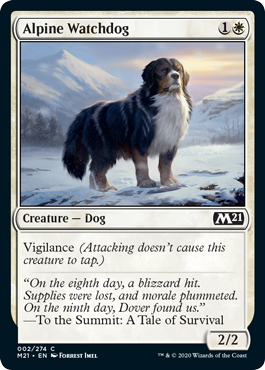
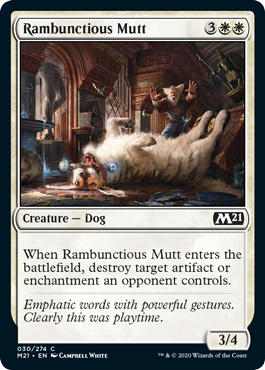
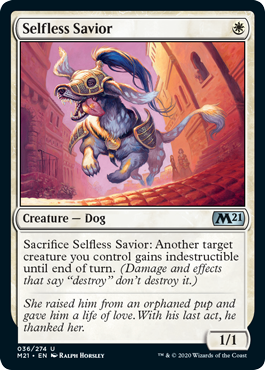
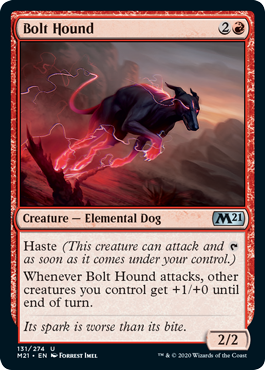
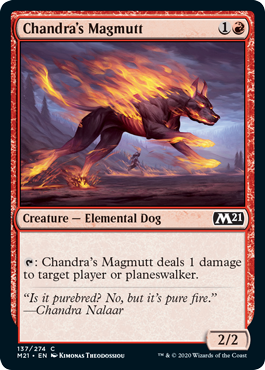
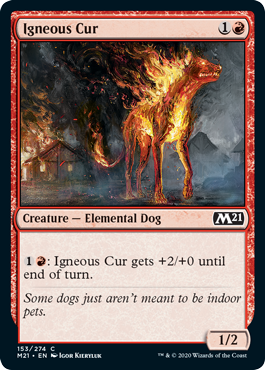
Also, the Buy-a-Box is both a Cat and a Dog and will allow you to make a three-color Cat and Dog deck. (There are four green Cats and one white Cat in Core Set 2021.)
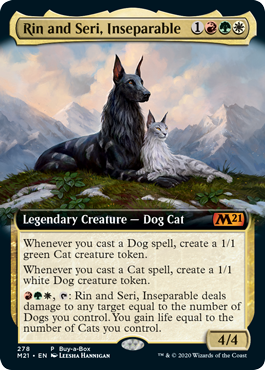
I also want to point out that Pack Leader is part of a loose cycle of rare tribal cards. The cards don't work similarly mechanically, but each encourages a specific tribal deck. In the cycle, blue helps Spirits, black helps Rogues, red helps Goblins, and green helps Cats. Here are the cards in the cycle that are known at this point.
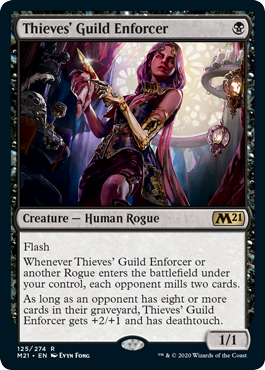
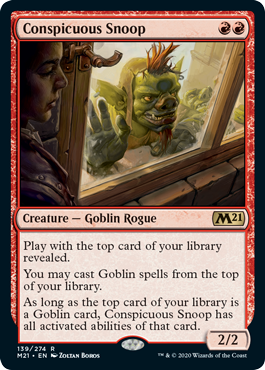
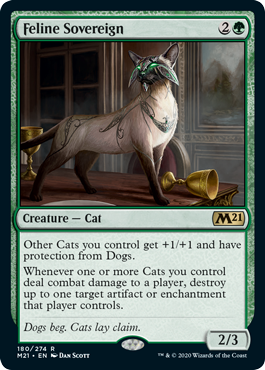
Just My Subtype
Regular readers of my blog know that there are certain topics that just keep popping up. Of all of them, the one that probably comes up the most often, to the point of being a running joke on the blog, is the request to return to Kamigawa. Back in 2004, we first visited Kamigawa in a set known as Champions of Kamigawa, a top-down set based on Japanese mythology. It was actually the first time we designed a top-down block (one could argue the first top-down set was Arabian Nights, Magic's first expansion). The first time you do something, it's not always your best work, and Champions block was a low point mechanically for Magic. (We have gotten a lot better at doing top-down sets.) As such, it didn't do all that well, which makes a return a tricky proposition.
That doesn't mean, though, that we can't deliver some goodies for all those Kamigawa fans, and my preview cards today hopefully should bring a smile to their face. You see, Core Set 2021 has a new cycle of Shrines. What exactly are Shrines? Let me show you.
Champions of Kamigawa block had a legendary theme. At the time, we'd made legendary creatures, legendary artifacts, and legendary lands, but not legendary enchantments. (As this was pre-planeswalkers, it was the only permanent type that hadn't gotten the legendary treatment.) Champions of Kamigawa wanted to change that. The big question wasn't creatively how to represent them (they were special, unique enchantments), but more mechanically. Why would enchantments need to be legendary? Mechanically, you could only have one on the battlefield at a time. Was there a way to make that relevant?
We tried a few different things, but what stood out pretty fast was the idea that the enchantments had a relationship with one another. That is, you wanted to get all of them on the battlefield. Because they were legendary, that meant you could only ever have one of each color, which, in turn, meant that we could push them quite a bit in what they did. The idea we eventually settled on was that each turn, they'd generate an effect that got stronger the more of them you had on the battlefield.
Mechanically, to make this work, we had to give the enchantments a subtype. Rules-wise, we needed to have something we could count. We chose Shrine. This way, when each card triggered, it could count the number of Shrines you controlled on the battlefield. Creatively, by the way, we chose to represent these enchantments as hondens, a Shinto shrine. This creative choice is probably why we chose the word shrine. While, overall, Champions of Kamigawa didn't do very well, the Shrines were popular.
Flash forward many years to Core Set 2021's set design. Adam Prosak and his team were looking for a rare cycle. They had the following criteria:
It had to tie to the past. They were looking to do something that more enfranchised players might recognize, ideally doing a new version of a cycle that had only ever been done the one time. The more beloved that cycle was, the better.
It had to be self-sufficient. The cycle had to be something cool for new players who might not know the reference, and it had to play well in Standard. If it had some combination with the old cycle in larger formats, that would be cool, but it wasn't required.
It would be nice if it was an enchantment cycle. Theros Beyond Death had a strong enchantment theme, and if this cycle were enchantments, it could tie into that. The set could also use more enchantments in general.
It couldn't use any non-evergreen mechanics. Core Set 2021 was a core set, which meant that it only has access to evergreen (or deciduous) mechanics. The cycle in question had to be something that didn't require any named non-evergreen mechanics. This actually cut out a number of interesting cycle options.
Adam had a meeting where they wrote all the ideas they could think up on a white board, and the idea that stood out as the favorite was the Shrines. Shrines were nice in that they were enchantments, had a tie to the past (meaning they would play well with the old Shrines), and were self-sufficient to allow you to play them in Standard. They checked off all the requirements.
Before I talk about their designs, let me first show them to you.
Click here to see the cycle of Shrines

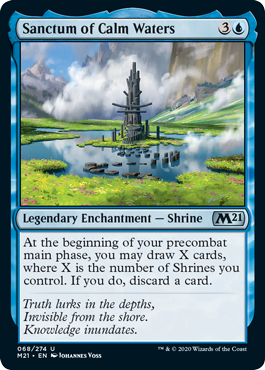
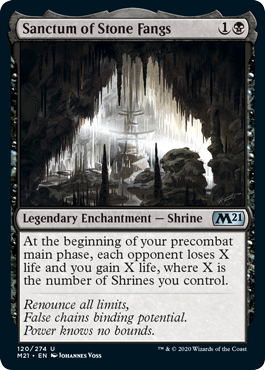
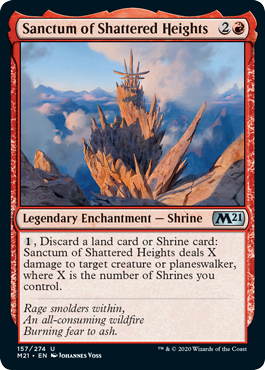
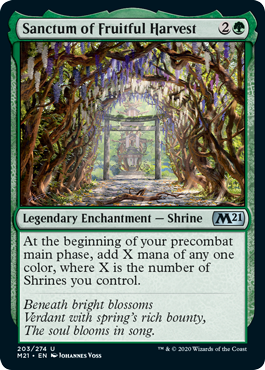
The initial intent was to not repeat any of the effects from the original five Shrines, but card draw and direct damage were so much better than the other options that the team decided to use them. You'll note that this cycle does a few things the previous Shrines did not do. For example, both the white and red Shrine have activated abilities rather than triggered ones.
But wait, we're not done yet. After the team made the Shrine cycle, they realized there was an opportunity to do something a little more. You see, they noticed that the Shrines were a bit like Slivers. Both mechanics push you toward playing a lot of different colors so you can get more of the thing the deck cares about onto the battlefield. Because of this five-color nature, most times the Slivers appear, they come with a five-color card. What if the Shrines could do that as well? That means I have one more preview card to show you. The Shrine cycle, it turns out, is not five cards, but six.
Click here to see Sanctum of All
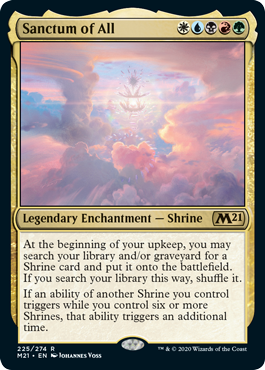
Sanctum of All encourages you to build a five-color Shrine deck and then gives you the task of acquiring all the Shrines. Note, if you play a format that includes Champions of Kamigawa, your Shrine deck gets five more cards, which makes Sanctum of All even easier to accomplish. I hope the Kamigawa fans, plus the rest of you, have fun with the Shrines.
The Core, The Merrier
That's all the time we have for today. I hope between last week and today, you've gotten a good sense of what's in Core Set 2021. As always, I'm eager to hear your feedback on the articles or the set itself. You can email me or contact me through any of my social media accounts (Twitter, Tumblr, Instagram, and TikTok).
Join me next week for card-by-card design stories from Core Set 2021.
Until then, may your Shrines shine.
#747: Dawn Murin
#747: Dawn Murin
32:04
In this podcast, I talk with Dawn Murin, one of the art directors for Magic.
#748: Blake Rasmussen
#748: Blake Rasmussen
30:11
In this podcast, I talk with Blake Rasmussen, one of the people in charge of communications for Magic.
- Episode 746 Brian Tinsman
- Episode 745 Matt Tabak
- Episode 744 Erik Lauer

